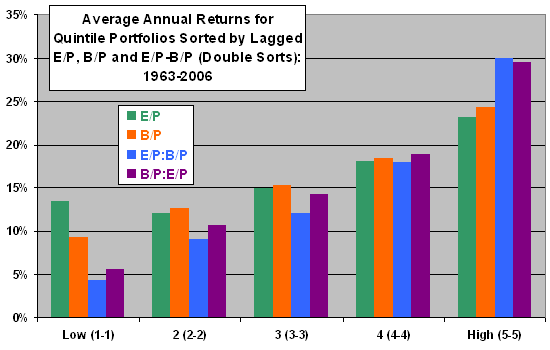Are stock earnings yield (E/P) and firm book-to-price ratio (B/P) complementary indicators of future stock returns? In their December 2009 paper entitled “Returns to Buying Earnings and Book Value: Accounting for Growth and Risk”, Francesco Reggiani and Stephen Penman investigate the interplay of E/P and B/P in an accounting context, including joint implications for future stock returns. The authors hypothesize that B/P measures the degree to which firms defer recognition of risky earnings. Using monthly stock return and firm financial data for a broad sample of U.S. stocks spanning 1963-2006 (153,858 firm-years over 44 years), they find that:
- E/P predicts stock returns, consistent with the idea that it measures risk to short-term earnings.
- B/P predicts stock returns, consistent with the idea that it measures accounting deferral of risky earnings and therefore risk to both short-term and long-term earnings. This perspective disrupts the traditional value-growth paradigm by associating expected earnings growth with high B/P.
- For a given E/P, B/P therefore predicts incremental return associated with expected earnings growth. A joint sort on E/P and B/P discovers this incremental return and therefore generates higher returns than a sort on E/P alone, attributable to additional risk (see the chart below).
- Results are somewhat stronger for the 1963-1984 subperiod than for the 1985-2006 subperiod.
- Results using consensus analyst forecasts rather than lagged earnings to calculate E/P over the 1977-2006 subperiod are similar, but not as strong.
The following chart, constructed from data in the paper, compares average annual returns for four sets of quintile portfolios over the entire 1963-2006 sample period, as follows:
- “E/P” sorts on lagged earnings yield.
- “B/P” sorts on lagged book-to-price ratio.
- “E/P:B/P” sorts first on E/P and then sorts each E/P quintile on B/P. Reported returns are for the nth B/P quintile within the nth E/P quintile (n-n).
- “B/P:E/P” sorts first on B/P and then sorts each B/P quintile on E/P. Reported returns are for the nth E/P quintile within the nth B/P quintile (n-n).
Start dates for return calculations are three months after fiscal year ends (when annual financial reports should be available). The holding period is 12 months. Results show that double sorts generally enhance performance discrimination among stocks. E/P measures risk to short-term earnings and therefore short-term earnings growth. B/P measures risk to short-term earnings and earnings growth and therefore incremental earnings growth. The incremental return for B/P is most striking in low E/P quintile.
Results apparently include no trading frictions.

In summary, evidence suggests that book-to-price ratio and earnings yield explain future stock returns better jointly than individually by more completely anticipating future earnings growth.